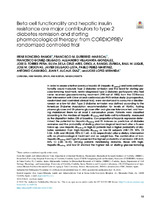Mostrar el registro sencillo del ítem
Beta cell functionality and hepatic insulin resistance are major contributors to type 2 diabetes remission and starting pharmacological therapy: from CORDIOPREV randomized controlled trial
| dc.contributor.author | Roncero-Ramos, Irene | |
| dc.contributor.author | Gutiérrez Mariscal, Francisco Miguel | |
| dc.contributor.author | Gómez Delgado, Francisco | |
| dc.contributor.author | Villasanta-González, Alejandro | |
| dc.contributor.author | Torres‑Peña, J.D. | |
| dc.contributor.author | Cruz‐Ares, Silvia de la | |
| dc.contributor.author | Rangel Zúñiga, Oriol Alberto | |
| dc.contributor.author | Luque, Raúl M. | |
| dc.contributor.author | Ordovas, José M. | |
| dc.contributor.author | Delgado-Lista, Javier | |
| dc.contributor.author | Pérez-Martínez, Pablo | |
| dc.contributor.author | Camargo García, A. | |
| dc.contributor.author | Alcalá Díaz, Juan Francisco | |
| dc.contributor.author | López-Miranda, José | |
| dc.date.accessioned | 2021-11-10T07:53:21Z | |
| dc.date.available | 2021-11-10T07:53:21Z | |
| dc.date.issued | 2021 | |
| dc.identifier.uri | http://hdl.handle.net/10396/22048 | |
| dc.description.abstract | In order to assess whether previous hepatic IR (Hepatic-IR fasting) and beta-cell functionality could modulate type 2 diabetes remission and the need for starting glucose- lowering treatment, newly-diagnosed type 2 diabetes participants who had never received glucose-lowering treatment (190 out of 1002) from the CORonary Diet Intervention with Olive oil and cardiovascular PREVention study (a prospective, randomized and controlled clinical trial), were randomized to consume a Mediterranean or a low-fat diet. Type 2 diabetes remission was defined according to the American Diabetes Association recommendation for levels of HbA1c, fasting plasma glucose and 2h plasma glucose after oral glucose tolerance test, and having maintained them for at least 2 consecutive years. Patients were classified according to the median of Hepatic-IR fasting and beta-cell functionality, measured as the disposition index (DI) at baseline. Cox proportional hazards regression determined the potential for Hepatic-IR fasting and DI indexes as predictors of diabetes remission and the probability of starting pharmacological treatment after a 5-year follow-up. Low-Hepatic-IR fasting or high-DI patients had a higher probability of diabetes remission than high-Hepatic-IR fasting or low-DI subjects (HR:1.79; 95% CI 1.06_3.05; and HR:2.66; 95% CI 1.60_4.43, respectively) after a dietary intervention with no pharmacological treatment and no weight loss. The combination of low- Hepatic-IR fasting and high-DI presented the highest probability of remission (HR:4.63; 95% CI 2.00_10.70). Among patients maintaining diabetes, those with high- Hepatic-IR fasting and low-DI showed the highest risk of starting glucose-lowering | es_ES |
| dc.format.mimetype | application/pdf | es_ES |
| dc.language.iso | eng | es_ES |
| dc.publisher | Elsevier | es_ES |
| dc.rights | https://creativecommons.org/licenses/by-nc-nd/4.0/ | es_ES |
| dc.source | Translational Research 238, 12-24 (2021) | es_ES |
| dc.subject | Type 2 Diabetes Mellitus | es_ES |
| dc.subject | Insulin resistance | es_ES |
| dc.subject | Hepatic insulin resistance | es_ES |
| dc.subject | CORDIOPREV | es_ES |
| dc.subject | Intervention studies | es_ES |
| dc.title | Beta cell functionality and hepatic insulin resistance are major contributors to type 2 diabetes remission and starting pharmacological therapy: from CORDIOPREV randomized controlled trial | es_ES |
| dc.type | info:eu-repo/semantics/article | es_ES |
| dc.relation.publisherversion | https://doi.org/10.1016/j.trsl.2021.07.001 | es_ES |
| dc.relation.projectID | Junta de Andalucía. CVI-7450 | es_ES |
| dc.relation.projectID | Gobierno de España. AGL2012/39615 | es_ES |
| dc.relation.projectID | Gobierno de España. AGL2015-67896-P | es_ES |
| dc.relation.projectID | Instituto de Salud Carlos III. PI10/01041 | es_ES |
| dc.relation.projectID | Instituto de Salud Carlos III. PI13/00023 | es_ES |
| dc.relation.projectID | Instituto de Salud Carlos III. CD16/ 00047 | es_ES |
| dc.rights.accessRights | info:eu-repo/semantics/openAccess | es_ES |

